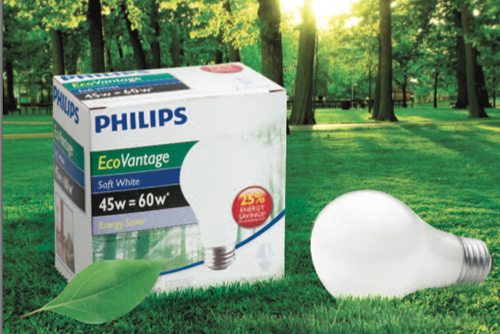 Do you avoid using compact fluorescent bulbs in your home because of the mercury they contain? If you do, but you’d still like to replace standard incandescent bulbs with something more energy efficient, take a look at the EcoVantage bulbs from Philips Electronics. These bulbs have been sold in limited release (online and in California), but they’ll be available in brick-and-mortar stores later this month. These bulbs are available in soft white, natural light, and clear. They are the standard A-shape, so they’ll fit in household fixtures and lamps. They contain no mercury, and they save 28% of the energy used by standard incandescents. EcoVantage bulbs comply with the Energy Independence and Security Act 2007 efficiency standards. If you can’t wait to get your hands on some, Amazon.com sells the Philips EcoVantage lightbulbs in 2-packs (prices vary between $5.00 and $8.00).
Do you avoid using compact fluorescent bulbs in your home because of the mercury they contain? If you do, but you’d still like to replace standard incandescent bulbs with something more energy efficient, take a look at the EcoVantage bulbs from Philips Electronics. These bulbs have been sold in limited release (online and in California), but they’ll be available in brick-and-mortar stores later this month. These bulbs are available in soft white, natural light, and clear. They are the standard A-shape, so they’ll fit in household fixtures and lamps. They contain no mercury, and they save 28% of the energy used by standard incandescents. EcoVantage bulbs comply with the Energy Independence and Security Act 2007 efficiency standards. If you can’t wait to get your hands on some, Amazon.com sells the Philips EcoVantage lightbulbs in 2-packs (prices vary between $5.00 and $8.00).

![[From INIU - the SAFE Fast Chage Pro] Experience the safest charging with over 38 million global users. At INIU, we use only the highest-grade materials, so we do have the confidence to provide an industry-leading 3-Year iNiu Care. [22.5W Speedy Char...](https://m.media-amazon.com/images/I/416nS4GRFtL._SL160_.jpg)

Gadgeteer Comment Policy - Please read before commenting
This is a little ridiculous, since nowhere does it say what it actually is!
Is it an incandescent? Doesn’t say!
Is it some sort of fluorescent? Doesn’t say!
What is it?
I think it is some sort of incandescent, but they don’t want to say so, because incandescent is bad.
I have noticed a lot of blurbs like these on the tech sites lately. It is very thinly veiled advertising and I am not amused.
Ken: After some googling, they appear to be some form of halogen. Halogen bulbs are a form of incandescent, but can be more efficient than standard incandescents by operating at higher temperatures. My recollection was that halogens were about 10-20% more efficient, but from reading there is a bulb lifetime-efficiency tradeoff, and halogens can be as much as four times as efficient, presumably with bulb lifetimes similar to standard incandescents–halogens I’ve seen offered as incandescent replacements fall in the 10-20% range but claim several times the bulb lifetime.
They are halogens. They have been out here in Australia for awhile. Basically a small halogen globe inside a standard shape bulb. Not as efficient as the compact flourescents but the light is closer to the old incandescents and easier to dispose of. Incandescents where banned here a few years ago.
Michael
OK. I guess that makes sense.
I thought Halogens were worse, because of the heat they generated.
Halogens are usually run at higher temperatures than standard incandescents, but this actually shifts more of the output energy into visible light–most of the output energy of a standard incandescent is in the infrared (actually, this is also true for halogens too, just less so).
I through with the “money saving” compact fluorescent bulbs. They may actually use much less energy while turned on, but I see three distinct problems:
– mercury (not my biggest concern, but the greenies go ape over stuff like this)
– they don’t fit in many existing fixtures
– they cost an arm and a leg, and in my experience last no longer than a cheapo incandescent
– they aren’t “instant on”, and I find the warm-up-to-full-brightness period annoying
– (oops…that’s four things not three)
This new bulb may be just the ticket…as long as the price is reasonable. I’ll definitely be giving them a try.
Another problem with fluorescents is they will overheat, and maybe catch fire, if used with a dimmer. You need special fluorescent bulbs if you want to use them with a dimmer.
@John. Yes, I forgot about that problem too. That makes 5 against the CFLs. Actually 6 if you consider that the CFL dimmables cost even more than the regular CFLs. They pushed the CFLs on us and like sheep we all bought into it. Well, I’m buying out!